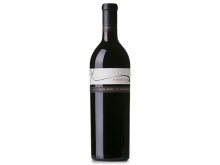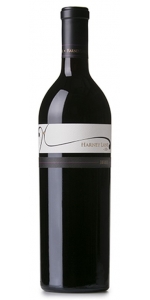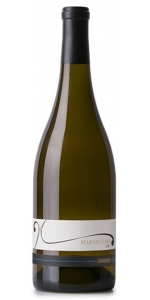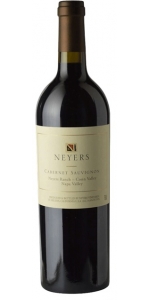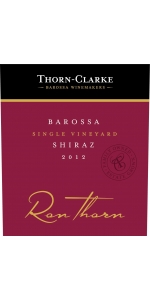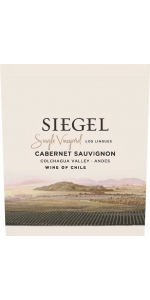Harney Lane Old Vine Zinfandel Lizzy James Vineyard 2017
| Country: | United States |
| Regions: | California California (Lodi) |
| Winery: | Harney Lane Winery and Vineyards |
| Grape Type: | Zinfandel |
| Organic: | Yes |
| Vintage: | 2017 |
| Bottle Size: | 750 ml |
Harney Lane Zinfandel Home Ranch is made from 100 percent 95% Zinfandel and 5% Petite Sirah .
The Home Ranch Zinfandel showcases Lodi’s terroir with distinct character. Dark ruby in color, it offers fragrant aromas of brambly fruit, black cherry and raspberry jam, highlighted with a whisper of savory spices and white pepper. The harmonious, elegant tannins create a warm, plush mouthfeel and silky finish on this rich full bodied wine.
Sub-appellation : Mokelumne River
T.A. : 6g/L
pH : 3.73
R.S. : 0.16%
Pairs with:
Saucy Lasagna
Roasted Beet Salad with Chèvre
Korean Sweet Short Ribs
Barbecue Pulled Pork Sandwiches
Harney Lane Chardonnay Home Ranch is made from 100 percent Chardonnay.
Fruit aromas of baked apple, ripe pear and pineapple are highlighted with pleasant notes of butterscotch, roasted nuts, honey and vanilla cream.
Sub-appellation : Mokelumne River
T.A. : 5.4g/L
pH : 3.71
R.S. : 0.3%
Pairs with , brown Butter Lobster, roasted Butternut Squash Pasta, creamy Risotto. Brie & Caramelized Onion Pizza
Harney Lane Chardonnay Home Ranch is made from 100 percent Chardonnay.
Fruit aromas of baked apple, ripe pear and pineapple are highlighted with pleasant notes of butterscotch, roasted nuts, honey and vanilla cream.
Sub-appellation : Mokelumne River
T.A. : 5.4g/L
pH : 3.71
R.S. : 0.3%
Pairs with , brown Butter Lobster, roasted Butternut Squash Pasta, creamy Risotto. Brie & Caramelized Onion Pizza
Neyers Cabernet Sauvignon Neyers Ranch is made from 100 percent Cabernet Sauvignon.
"We harvested the 2017 Cabernet Sauvignon crop from our Conn Valley Ranch in the first week of October, a week later than we picked the same vineyard the prior year. The size of the crop was about 20% smaller in 2017 as well, mostly due to the cold, wet weather we experienced in spring during flowering. Grapevines are self-pollinating, and cold, windy or damp weather interferes with this process, a problem known the French call coulure. Ironically, the harsh spring weather of 2017 had a huge impact on the size of our crop. Still, this smaller crop ripened fully and evenly, and at harvest time we picked beautiful, dark-colored clusters under near-perfect conditions. The finished wine was immediately remarkable for its flavor and complexity, and the wine looks to be one that will improve for many years. During my career in the Napa Valley wine business, I’ve learned to expect the best wines from cold years like 2017. These are vintages that are viewed initially with lowered expectations, but my experience has been just the opposite. Going back to my first Napa Valley harvest in 1971, these ‘colder years’ invariably result in wines with brighter, more attractive flavors, and the wines age longer and more gracefully.
Following harvest, the wine was fermented using wild, native yeast in an temperature-controlled stainless steel tank. After 45 days or so, the tank was drained and the pomace pressed, and the wine transferred to 60-gallon French oak barrels, 25% of them new. During the first year, we racked the wine off of the yeast lees three times, and by May 2019 it had been sufficiently clarified to bottle without fining or filtration. I am especially impressed by its bright ruby hue, a color so commanding it reminded me of the 1995 red Bordeaux wines I tasted from barrel during my trip to France in the Spring of 1996. It’s loaded with flavors that range from wild cherry to chocolate, enhanced by the lovely hint of tobacco leaf and mint. Each aromatic component has its own individual fascination, but all of them together provide a remarkable experience. Here’s a complete Napa Valley Cabernet Sauvignon that we expect it to improve for 20 years. It's a from a very small crop that will provide decades of pleasure." - Bruce Neyers
Review:
Attractive aromas of blueberries and lavender follow through to a medium body, firm and silky tannins and a slightly chewy finish. Needs a couple of years to soften. Better after 2022.
-James Suckling 93 Points
Deep red with a slight purple hue on release. The wine has a rich mix of dark chocolate infused with coffee bean and black liquorice, then scents of tar, aniseed, raw (pure) soy and black olive on the nose. The palate is expansive, and yet balanced and finessed. An amalgam of dark berried flavors and textural sensations. The 100% new oak is completely absorbed, meshed with ripe tannins, completing a palate of impressive length and youthfulness.
Slowly the tide turned, Australians began drinking more wine and Dad with his uncanny ability to select and plant Clifton Park with the grape varieties of the future, saw fortunes change for Clifton Park and the Thorn family. I loved my Dad's wry sense of humor and his work ethic was an inspiration to us all.
"My father, Ron, was born in 1923 at the Angaston Hospital not far from where the Thorn-Clarke Winery is currently located. He was the fourth born of the nine children my grandparents raised at Clifton Park in the Eden Valley Ranges. Dad's great-grandparents took up farming land in the Barossa in the 1840's and purchased Clifton Park, where Dad grew up, in the 1870's. To this day, Clifton Park remains in the Thorn family and the 1870's vineyard still produces quality fruit.
As the family grew, Dad showed tenacity and judgment by pulling out orchards and extending the family vineyards. During the 1950's, 60's, and 70's, times were testing for a family business based on dry land horticulture and mixed farming. Dad's strong work ethic proved an invaluable asset during the tough years on the farm and he traveled widely as a shearer, drove bulldozers and worked at the local cement works to support his family.
Ron Thorn Shiraz is made from the best fruit that we grow and is produced only in exceptional years. This wine is given the benefit of 20 months barrel maturation and 12 months in bottle prior to release. This is our tribute to Dad's life and his contribution to the Thorn-Clarke story." - Cheryl Thorn Clarke
Review:
- James Suckling (November 2021), 93 pts
Siegel Single Vineyard Los Lingues Cabernet Sauvignon is made from 100% Cabernet Sauvignon.
Viña Siegel Single Vineyard Cabernet Sauvignon is the result of our family's continuous search for quality wines with personality which faithfully reflect the best of our terroir. This wine comes from selected grapes from our "Los Lingues" vineyard in Alto Colchagua.
Located in the foothills of the Andes where the influence of the Andean winds result in an elegant Cabernet Sauvignon with great concentration of ripe red fruits, cassis and chocolate, and a balanced, richly structured, and long finish.
An intense violet color. Smells of cassis and is complemented with notes of mature red fruit and chocolate. A round and elegant wine with an excellent final persistence.
After carefully determining the moment for the harvest, the grapes are harvested by hand and later de-stemmed and marinated in cold temperatures for 5-6 days. Alcoholic fermentation is between 26ºC and 29ºC during which daily reassembly is implemented according to taste.Post-fermentation infusion lasts for two or three weeks. Once the blend is made, the wine is gently clarified and stabilized in cool temperatures if necessary.
Review:
"The 2017 vintage of the Los Lingues Cabernet Sauvignon is in every respect the equal of the 2016, which we rated highly. It begins with smoky, dark fruited nose and proceeds to a round, silky, well balanced palate of mineral-inflected, herbal-tinged dark cassis. There’s a sense of refinement and balance to this wine."
- I-winereview.com (March 2022), 92+ pts
Harney Lane Old Vine Zinfandel Lizzy James Vineyard is made from 100 percent Zinfandel.
Unabashedly ripe, but keeping true to it’s vineyard driven Zinfandel fruit notes of dark morello cherry, blackberry and pomegranate jelly. This full-bodied wine is deep with concentration, supple and polished with a careful measure of sweet oak that supports the generous fruit flavors.
Lizzy James Vineyard is registered as a Historical Vineyard by the Historical Vineyard Society; The vineyard name is the middle names of our children which were given to them in honor of grandparents.
Sub-appellation : Mokelumne River
T.A. : 6.5 g/L
pH : 3.8
R.S. : 0.4 %
Located in Lodi, California, Harney lane is owned and operated by Kyle and Jorja Lerner.
The Vineyard Philosophy: We always say that great wine starts in the vineyard. As a family owned and farmed property, we are fortunate enough to have 100% control over our wines- from grape to glass- ensuring the best possible product for our customers.
It would be hard to imagine Vineyard Manager, Kyle Lerner, doing anything but farming. His love of the land and being out in the vineyards has become a true passion, more than just a career. For Kyle, loving the land means taking care of it in a responsible way for generations to come. It also means embracing the challenges that each year brings- and anyone who knows him will tell you that Kyle loves a challenge. Every year is different, and that keeps farming exciting.
We vigilantly farm our vineyards so that we have a jump start on excellent quality wines. From planting and tending the grapes every season, to harvest and crush, to bottling. We handle our winemaking with the same care as our vineyards: our fruit is handpicked, hand sorted, fermented in small lots and then barrel aged in programs unique to each of the wines in our portfolio
- back
Franz Prager, co-founder of the Vinea Wachau, had already earned a reputation for his wines when Toni Bodenstein married into the family. Bodenstein’s passion for biodiversity and old terraces, coupled with brilliant winemaking, places Prager in the highest echelon of Austrian producers.
Smaragd is a designation of ripeness for dry wines used exclusively by members of the Vinea Wachau. The wines must have minimum alcohol of 12.5%. The grapes are hand-harvested, typically in October and November, and are sent directly to press where they spontaneously ferment in stainless-steel tanks.
Klaus sits adjacent to Achleiten and is one of the Wachau’s most famous vineyards for Riesling. The vineyard is incredibly steep with a gradient of 77% at its steepest point. The southeast-facing terraced vineyard of dark migmatite-amphibolite and paragneiss produces a tightly wound and powerful wine. The parcel belonging to Toni Bodenstein was planted in 1952.
Tasting Notes:
Austrian Riesling is often defined by elevated levels of dry extract thanks to a lengthy ripening period and freshness due to dramatic temperature swings between day and night. “Klaus is not a charming Riesling,” says Toni Bodenstein with a wink. Klaus is Prager’s most assertive and robust Riesling.
Food Pairing
Riesling’s high acidity makes it one of the most versatile wines at the table. Riesling can be used to cut the fattiness of foods such as pork or sausages and can tame some saltiness. Conversely, it can highlight foods such as fish or vegetables in the same way a squeeze of lemon or a vinaigrette might.
Review:
Superbly cool, restrained and refined, this austere, beautiful dry riesling is a slow-burn masterpiece that's only just beginning to reveal its complex white-peach, white-tea, wild-herb and dark-berry character. Super-long and mineral finish. Drink or hold.
-James Suckling 97 Points
Pago de Carraovejas Cuesta Liebres is made from 100% Tinto Fino. The plot is located on a terraced hillside located at 900 m above sea level with slopes that range between inclines of 30% and 40%. Red cherry color with purple hues. Ripe fruit aromas, vanilla notes. Suave and unctuous in the mouth. A strong and noble character.
The harvest is carried out by hand using small crates and after passing through a refrigerated container it is transferred into tanks via gravity. The alcoholic and malolatic fermentation is carried out in small French “Haute Futaie” Oak casks with unique and original local yeasts and fermenting bacteria from the vineyard itself, to bring out the very best of the terroir, respecting the uniqueness of each and every vintage. Clarified with egg whites and bottled by gravity with natural cork stoppers.
Review:
"From the vineyard of the same name, the 2021 Cuesta De Las Liebres is a knockout, from a hillside vineyard of terraced vines. Aged 24 months in French oak, the first year in new, the second in second-use, all fine-grained, and bottled in June 2024, the tannins are well-integrated and dusty, nearly chalky. It’s truly a beautiful expression of variety, vintage, and site, reaching perfection in its fine-tuned, full-bodied layers of rich cassis, oak spice, and even a touch of garrigue. There’s lovely acidity throughout that brightens the palate, with beguiling notes of violet that never fade away. It’s a seamless, polished, gorgeous wine that will be hard to resist, though aging will continue to see it melt into one over the next 15-18 years. - Virginie BOONE"
- Jeb DUNNUCK (August 2025), 100 pts

